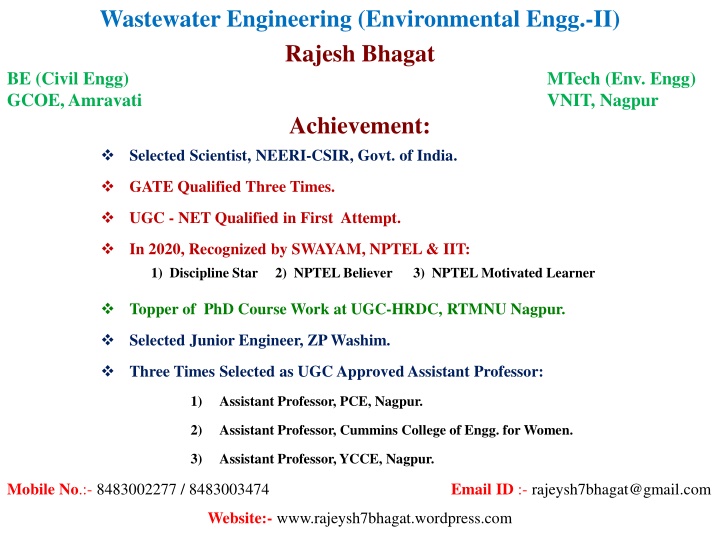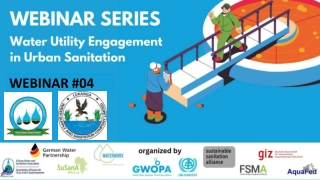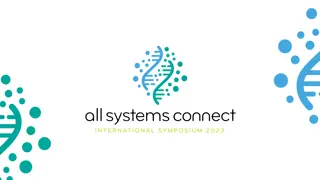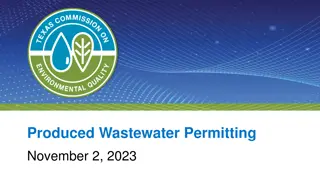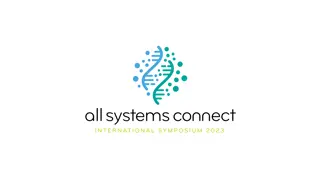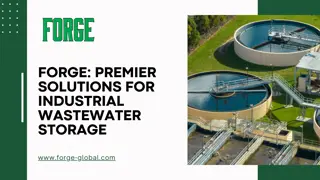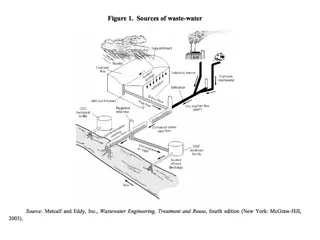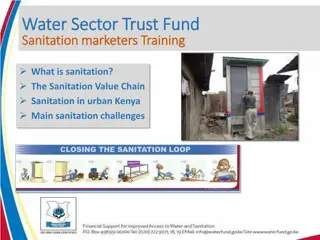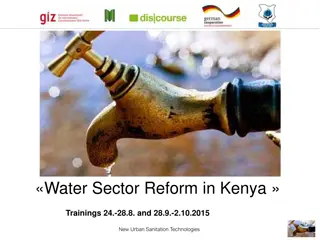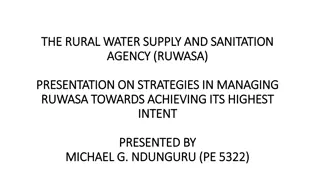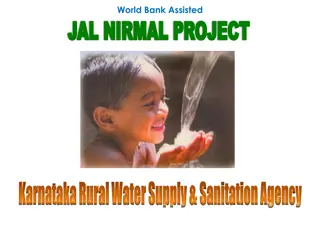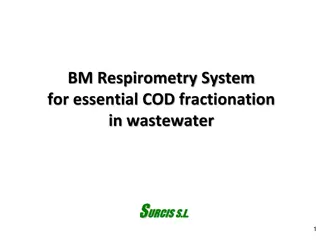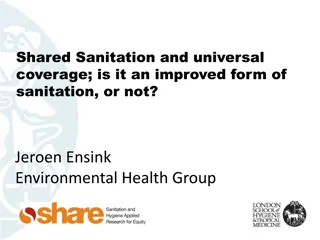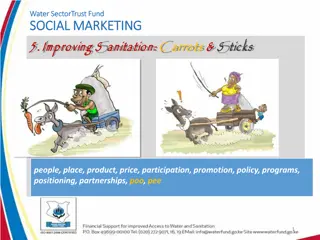Rural Sanitation and Wastewater Management Practices
Rural sanitation plays a crucial role in maintaining sanitary conditions in villages and small towns, where more than 70% of the population resides in India. The implementation of proper waste disposal facilities, such as pit privies and eco-sanitation systems, is essential to prevent the spread of diseases. Additionally, effective collection and disposal of sullage and the use of various types of privies are key components of rural sanitation practices.
Download Presentation

Please find below an Image/Link to download the presentation.
The content on the website is provided AS IS for your information and personal use only. It may not be sold, licensed, or shared on other websites without obtaining consent from the author.If you encounter any issues during the download, it is possible that the publisher has removed the file from their server.
You are allowed to download the files provided on this website for personal or commercial use, subject to the condition that they are used lawfully. All files are the property of their respective owners.
The content on the website is provided AS IS for your information and personal use only. It may not be sold, licensed, or shared on other websites without obtaining consent from the author.
E N D
Presentation Transcript
Wastewater Engineering (Environmental Engg.-II) Rajesh Bhagat BE (Civil Engg) GCOE, Amravati Achievement: Selected Scientist, NEERI-CSIR, Govt. of India. MTech (Env. Engg) VNIT, Nagpur GATE Qualified Three Times. UGC - NET Qualified in First Attempt. In 2020, Recognized by SWAYAM, NPTEL & IIT: 1) Discipline Star 2) NPTEL Believer 3) NPTEL Motivated Learner Topper of PhD Course Work at UGC-HRDC, RTMNU Nagpur. Selected Junior Engineer, ZP Washim. Three Times Selected as UGC Approved Assistant Professor: 1) Assistant Professor, PCE, Nagpur. 2) Assistant Professor, Cummins College of Engg. for Women. 3) Assistant Professor, YCCE, Nagpur. Mobile No.:- 8483002277 / 8483003474 Email ID :- rajeysh7bhagat@gmail.com Website:- www.rajeysh7bhagat.wordpress.com
UNIT-V 1) Rural Sanitation: Pit Privy, Aqua Privy, Bio-gas Recovery, Eco-Sanitation. Septic Tank & Design, Soak Pit, Imhoff Tank. 2) Industrial Waste Water Treatment: Basic concepts of industrial wastewater treatment, flow equalization, neutralization. common treatment alternatives for industrial waste water. 2
Rural Sanitation:- The term rural sanitation is used to indicate the development or maintenance sanitary condition in rural areas. In India, more than 70% of population resides in villages and small towns. Sanitary conditions are quite poor due to the absence of piped water supply and the sewerage system. Necessity of Rural Sanitation:- 1) There is no proper waste disposal facilities in rural area therefore many a people fall victim to various diseases like typhoid, dysentery, etc. 2) It is therefore necessary to provide better facilities like construction bore-hole privy, latrines and surface drainage, etc. 3) Also there should be arrangement for drainage of storm water. 4) Well should be properly protected from nearby drains & contamination. To provide good quality of tapped water.
Collection & Disposal of Sullage :- Sullage is wastewater from bathroom, kitchen, cloth washing, house washing, etc. & it does not create bad smell. Proper drains to convey it to small pits, water body, natural streams, pond, agricultural fields, land areas to percolate & evaporate. Privies:- In conservancy system, the human excreta is collected by various types of container or structure known as privy.
Types of privy :- 1) Trench privy 2) Pit privy or Dug well privy 3) Bore hole privy 4) Can privy 5) Concrete vault privy 6) Chemical toilet 7) Aqua privy 8) Pour flush water seal latrine Trench Privy:- 1) Used as temporary measure during fairs, camps, etc. 2) Consists of rows of parallel trenches 0.9m long, 0.3m wide & 0.4m deep. 5 3) The faeces, urine & ablution water fall directly into the trench.
Pit Privy:- 1) Consists of pit 0.9m to 1.2m in diameter & 2 to 4 m deep. 2) Pit may be lined or unlined but its bottom is unlined. 3) Pit is covered with squatting plate. 4) When pit gets filled, the squatting plate or superstructure is shifted to another pit and the old one is covered with earth. 5) Soil bacteria renders excreta harmless after a couple of months, when the contents can be turned over and used as a manure. 6) Its use is restricted due to place and space. 7) Water table should be low to avoid pollution of GW. 8) Odor problem can be controlled by use of lime. 6 9) This is very economical and require no operations.
Bore Hole Privy:- 1) Constructed where space available is less. 2) Similar to pit privy except depth is more. 3) Consists of hole of 0.3m to 0.4m diameter & 5 to 6m deep. Can Privy:- 1) Also known as removable receptable privy. 2) Oldest method & still used in rural area. 3) Can is placed under the seat or squatting plate for the collection of the faeces, urine & ablution water. 8 4) Initial cost is low but servicing cost is high.
Concrete Vault Privy:- 1) Improved form of pit or bore hole privy. 2) Used in sandy soils or in locations where ground water-table is high. 3) Watertight concrete vault or chamber constructed underground for collection & storage of faecal matter. 4) Squatting seat is provided over the top of vault. 5) No water is used. 6) When it is filled, then emptied through the manhole. Chemical Toilet: 1) Concrete vault is replaced by an acid proof metal tank. 2) Tank is of capacity 600 liters. 3) The caustic soda helps to stabilize the organic matter present in the excreta. 4) Cost is more hence not used in rural areas. 9 5) Used in aircraft.
Aqua privy:- (Wet Latrine) 1) It is based on the principle of septic tank action where by the tendency of excreta to liquefy an- aerobically when enclosed in a water tight tank. 2) It consist of square plate with a drop pipe 10cm diameter extending 10 to 15cm into a water tight tank to point below the water tank. 3) Faeces and urine fall into the tank where they undergo decomposition as in the septic tank. 4) The solid are reduced in volume to about a quarter of the faeces deposited. 5) The effluent is directed from the tank to undergo further treatment either in the seepage pit or subsoil absorption field. 6) Solids remaining in the tank have to be removed periodically.
Pour Flush Water Seal Latrine: 1) The excreta is hand flushed by pouring about 1.5 to 2 litres of water. 2) Consists of leaching pits located slightly away from the pan. 3) Usually two leaching pits are provided but at a time squatting pan is connected to only one pit. 4) The filled pit may be emptied after one to two years when excreta gets completely digested & most of pathogens die off. 5) The digested excreta may be used as manure, thus the two pits can be used alternately and perpetually. 6) Provides very satisfactory and hygienic sanitation system for rural areas. 7) Can be located inside the house since the water seal would prevent odor & insect nuisance.
Requirements of Good Privy: 1) It should be located away from the building on the leeward side. 2) The squatting pan should be well above the ground surface to prevent entry of rain water. 3) It should be well ventilated. 4) The receptable to receive excreta should be of sufficient capacity so as to hold at least 24 hours the faeces, urine and ablution water. 5) It should be remain closely covered so that flies do not reach there. 6) Contents should not be visible to the user. 7) Economical.
Bio-Gas Production: 1) Plays a significant role in sanitation. . 2) Powerful source of energy & fertilizer supply in rural areas. 3) Anaerobic fermentation of organic substances such as cattle dung (gobar), green leaves, animal urine, animal fodder, night soil, kitchen waste, etc. 4) Biogas is mixture of 2/3 rd of methane (combustible) & 1/3 rd is carbon dioxide with traces of nitrogen, hydrogen sulphide, hydrogen, oxygen, & ammonia.
Uses of Bio-Gas Production: 1) Used for cooking, lighting, driving oil & gas engine. 2) Makes an efficient use of the slurry produced after digestion in the bio-gas. (Compost) NPK 3) Eliminate nuisance due to mosquitoes, flies & insect breeding on exposed cattle dung. 4) Prevent of eye diseases caused by burning cattle dung cakes in chullahs. 5) Eliminates pollution of atmosphere due to smoke from chullahs.
Septic Tank :- 1) In rural area or in case of isolated building underground sewerage system with complete treatment of sewage neither be feasible nor be economical. 2) Under such cases, septic tanks are preferred by subsurface disposal off effluent are provided in area having porous soil. 3) Location of septic tank should be away from the building. 4) Septic tanks are horizontal continuous flow, small sedimentation tanks through which sewage is allowed to flow slowly to enable the sewage solids to settle to the bottom of the tank, where they are digested anaerobically. 5) Biochemical reactions by anaerobic bacteria takes place. 6) The tank is de-sludged at regular intervals usually once every 1-5 years. 7) Effluent is taken to soak pits for disposal. 8) The bad smell occur during the digestion period of sludge & hence septic tank are 18 provided with cover at the top.
Septic Tank :- 1) A septic tank is a combined sedimentation & digestion tank where sewage is held for one or two days. 2) During this period, the suspended solids settle down to the bottom. 3) Anaerobic decomposition of settled solids resulting in reduction in volume of sludge by converting it to liquid and gases. 4) The anaerobic decomposition gives rise to septic condition, hence this tank is called septic tank. 5) Although, waste in septic is clarified to a large extent, is still sufficiently foul in nature, containing organic solids & pathogens. 6) Therefore, needs proper disposal methods like Soak pit or seepage pit, Dispersion trench, up-flow anaerobic filters & biological filters. 21
Disposal of Septic Tank Effluent:- Effluent is malodorous containing pathogenic organism hence needs to be disposed of carefully. Disposed of by land disposal methods or soil absorption methods. Effluents is allowed to be soaked or absorbed by surrounding soil. 1. Soak Pits or Seepage Pits 2. Dispersion Trenches 22
Soak Pit or Seepage Pit:- 1) A circular covered pit, through which effluent is allowed to be soaked into surrounding soil. 2) Soak pit may either be filled with some stones or aggregates or may kept empty. 3) Effluent of aqua privy, septic tank or sullage from bathrooms & kitchens. 4) Difference between soak pit & cesspool is that the soak pit is completely filled up with stones. 5) The fine suspended solids adhere to the surface of stones and get decomposed by the film, which are on the stones and the effluent is leached into the side walls. 23
Dispersion Trenches:- Narrow & shallow trenches about 0.5 to 1 m deep & 0.3 to 1 m wide excavated to a slight gradient of about 0.25%. Open jointed earthware or concrete pipes of 80 to 100 mm diameter are laid in the trenches over a bed of 15 to 25 cm of gravel. 24
Leaching Cesspools:- 1) Circular or rectangular underground tank or chamber. 2) Top portion acts as an absorption field & bottom field acts as a septic tank. 3) Sewage effluent easily disperse into surrounding soil. 4) Bottom portion is made up watertight to retain heavier sludge for septic action or digestion. 5) Sometime bottom may not be watertight. 25
Imhoff Tank:- 1) Improvement over the plain septic tank. 2) Both sedimentation and sludge digestion takes place in the same structured. 3) Contains two compartment one for sedimentation and another for sludge digestion. 4) Upper chamber is known as sedimentation chamber & lower chamber is digestion chamber. 5) Quite economical & not require any skilled attention during operation. 6) Combined advantages of septic tank & sedimentation tank. 7) No moving parts. 8) It is possible to dry easily the sludge. 9) Process is better than septic tank. 10) No adequate control over operation. 11) May give out offensive odor. 12) Depth is more than septic tank. 13) Have tendency to foam or boil (scum at top) 26 14) Unsuitbale for highly acidic sewage.
Eco Sanitation:- Ecological Sanitation ( Eco-San ) Ecological sanitation is a new paradigm in sanitation that recognises human excreta and water from households not as a waste but as resources that can be recovered, treated, where necessary, and safely used again. Ecological sanitation systems offer a range of low cost to high tech sanitation options which are hygienically safe, comfortable to use, environmentally friendly and often more economic than conventional systems. In addition, they ideally enable a complete recovery of nutrients in household wastewater and their reuse in agriculture 27
Design a septic tank for a small colony of 200 person provided with a water supply of 200 litres per person per day. Assume suitable data required. Sol.: Assuming 80% of water supplied appears as sewage. Total quantity of sewage produced = 200 x 200 x 0.8 = 32000 litres / day = 32 m3/day Assume detention time = 24 hours Capacity of tank required sewage storage = 32 ( 24/24) = 32 m3 Assume capacity of sludge storage = 30 litres per capita per year Peroid of cleaning one year Capacity for sludge storage = 30 x 200 x 1 = 6000 litres = 6 m3 Total capacity of tank = 32 + 6 = 38 m3 Assume liquid depth = 1.2m Surface area of tank = 38 / 1.2 = 31.67 m2 Take L/B = 2.5 L x B = 31.67 2.5 B x B = 31.67 B = 3.6m & L = 9m Assume FB = 0.3m Total depth of tank = 1.2 + 0.3 = 1.5m Hence provide 9 X 3.6 x 1.5 m 28
Design a septic tank for hostel with the following data: No. of users = 150 Peak discharge = 205 lpm Desludging period = 1 year 33
Industrial Wastewater Treatment:- a) Characteristics of industrial sewage differ considerably from domestic sewage. b) Characteristics of industrial sewage vary with the type of industry and even in the same type of industry they vary according to the process involved. c) Industrial sewage contains chemical pollutants & toxic substances in large proportions. d) Industrial sewage needs proper treatment before disposal. e) Various industries are classified based on characteristics of sewage. 1) Food & food processing industries like sugar, canning, dairy, fermentation, etc. 2) Chemical processing industries like chemical manufacturing, paper & pulp, tannery, textile, rubber, electroplating, etc. 3) Mineral Product industries like iron, steel, oil, petroleum, coal, coke, gas, etc. 4) Other industries like atomic power plants, etc.
General Characteristics of Industrial Wastewater:- 1) Industrial sewage has a high proportion of suspended solids, dissolved organic and inorganic solids, BOD, alkalinity or acidity, etc. 2) Contaminants or constituents are usually not in the same proportion as they exist in a normal domestic sewage. 3) Industrial sewage may also contain toxic substance. Various constituents present in industrial wastewater: Organic substances depletes DO of river. Inorganic substances are undesirable for plants growths in water body & which render the water body unfit for further use. Acids & Alkalies cause serious problems in the operation of treatment units. Color producing substances imparts objectionable color. Oil & Grease hinder self-purification of river. Toxic Substances greatly affect the flora & fauna of water body.
Toxic Substances in Industrial Sewage:- Industry Toxic Substances Fertilizers Arsenic, Cyanide, Ammonia Coke Ovens Phenol, Cyanide, Thiocyanate, Ammonia Metallurgical Heavy Metals like Copper, Zinc, Cadmium Electroplating Chromium, Cadmium, Zinc, Copper Petrochemicals Phenols, Heavy Metals, Cyanide
Processes Involved in Industrial Wastewater Treatment:- 1) Equalization 2) Neutralization 3) Physical Treatment 4) Chemical Treatment 5) Biological Treatment Factors affecting selection of processes: Flow, Concentration of pollutants, Presence of non biodegradable organics, toxicity, etc
Equalization:- Holding the sewage for predetermined time in a continuously mixed tanks so as to get sewage of uniform character and at uniform rate. 1) To facilitate maintenance of uniform flow rate in the treatment units, flow equalization is used. 2) To overcome the operational problems caused by flow variation and improves performance of the treatment plant. 3) For dampening the flow rate variations so that a constant or nearly constant flow rate is achieved. For dampening the fluctuation in pollutant concentration in the incoming wastewater to avoid shock loading on the treatment system. 4) To provide continuous feeding to the treatment system when the wastewater generation is intermittent. 5) To control pH fluctuations or to control toxic concentration in the feed to the biological reactor. 6) To control the discharge of industrial effluent in to the sanitary sewers.
Neutralization:- 1) This necessary when the sewage is either excessively alkaline or acidic and it is achieved by the addition of either acid or alkali respectively. 2) This may be done either in the equalization tank where possible, or else in a separate neutralization tank.
Physical Treatment:- 1) Physical treatment of industrial sewage is similar to primary treatment of domestic sewage. 2) Various processes that are included in physical treatment of industrial sewage are : Screening, Sedimentation & Floatation. Floatation: - 1) Floatation is adopted to remove the finer particles from the industrial sewage. 2) Creating fine air bubbles in the sewage tank by introducing air into tank from the bottom. 3) Rising air bubbles attach themselves to the suspended particles thereby increase their buoyancy and lift them to the liquid surface from where these are removed by skimming.
Chemical Treatment:- 1) Chemical treatment of industrial sewage is often necessary before it is subjected to biological treatment. However, in some case chemical treatment may not be required and in some cases the chemical treatment may be the final stage of treatment. 2) Chemical Oxidation 3) Chemical Precipitation 4) Adsorption 5) De-ionisation 6) Thermal Reduction 7) Air Stripping 8) Reverse Osmosis 9) Electrodialysis
Adsorption:- Many industrial wastes contain refractory organics, which are difficult or impossible to remove through conventional biological treatment. These materials can be removed by adsorption on activated carbon or synthetic active-solid surface. The degree to which adsorption will occur and the resulting equilibrium relationships have been correlated according to the empirical relationship of Freundlich or the theoretically derived Langmuir relationship.
Ion Exchange :- Ion exchange can be used for the removal of undesirable anions and cations from a wastewater. Cations are exchanged for hydrogen or sodium and anions for hydroxyl ions. Ion exchange resins consist of an organic or inorganic network structure with attached functional groups. Most ion exchange resins used in wastewater treatment are synthetic resins made by the polymerisation of organic compounds into a porous three-dimensional structure.
Membrane Processes: Membrane processes can be classified according to the size range of the separated species: 1) Reverse osmosis is used to separate dissolved salts and small organics (size under 1 nm). Example: production of drinking water from seawater or seawater desalination. 2) Nanofiltration is used to separate antibiotics (size under 10 nm). Example: selective demineralisation of water or concentration of organic solutions. 3) Ultrafiltration is used to separate emulsions, colloids,macromolecules or proteins (size under 100 nm).Example: treatment of pulp and paper industry s effluents. 4) Microfiltration
